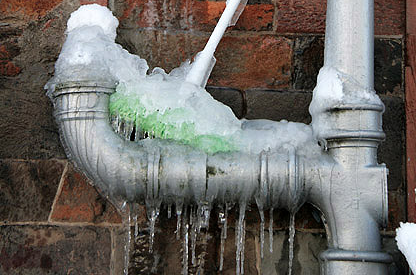Guidance for Avoiding Frozen Plumbing in Cold Weather: Specialist Tips
Guidance for Avoiding Frozen Plumbing in Cold Weather: Specialist Tips
Blog Article
We have unearthed this post pertaining to Helpful Tips to Prevent Frozen Pipes this Winter below on the web and thought it made sense to relate it with you in this article.

Cold weather can wreak havoc on your pipes, specifically by freezing pipelines. Right here's how to prevent it from taking place and what to do if it does.
Introduction
As temperatures decline, the risk of frozen pipelines increases, possibly causing costly fixings and water damage. Recognizing exactly how to avoid frozen pipes is crucial for home owners in cold climates.
Understanding Icy Pipelines
What creates pipelines to ice up?
Pipelines ice up when revealed to temperatures below 32 ° F (0 ° C) for extended durations. As water inside the pipelines ices up, it increases, taxing the pipeline walls and possibly triggering them to rupture.
Threats and problems
Icy pipelines can cause water disturbances, building damage, and costly repair services. Burst pipelines can flood homes and cause substantial structural damages.
Signs of Frozen Piping
Determining frozen pipes early can stop them from breaking.
How to determine frozen pipelines
Look for reduced water flow from taps, uncommon odors or noises from pipes, and noticeable frost on subjected pipelines.
Prevention Tips
Protecting vulnerable pipes
Cover pipes in insulation sleeves or utilize warmth tape to protect them from freezing temperatures. Concentrate on pipes in unheated or exterior areas of the home.
Heating techniques
Maintain indoor rooms sufficiently heated up, specifically locations with pipes. Open up closet doors to enable warm air to flow around pipelines under sinks.
Protecting Outdoor Pipes
Yard hoses and exterior taps
Detach and drain garden hose pipes prior to winter months. Install frost-proof spigots or cover outdoor faucets with shielded caps.
What to Do If Your Pipes Freeze
Immediate activities to take
If you presume frozen pipelines, maintain taps open to soothe pressure as the ice melts. Use a hairdryer or towels soaked in warm water to thaw pipes slowly.
Long-Term Solutions
Structural modifications
Consider rerouting pipes away from outside walls or unheated locations. Add added insulation to attic rooms, basements, and crawl spaces.
Updating insulation
Invest in top notch insulation for pipelines, attics, and wall surfaces. Proper insulation assists maintain consistent temperatures and reduces the danger of icy pipes.
Verdict
Preventing frozen pipelines needs aggressive steps and fast reactions. By comprehending the reasons, indications, and safety nets, home owners can safeguard their pipes during cold weather.
6 Proven Ways to Prevent Frozen Pipes and Protect Your Home
Disconnect and Drain Garden Hoses
Before winter arrives, start by disconnecting your garden hoses and draining any remaining water. Close the shut-off valves that supply outdoor hose bibs and leave the outdoor faucet open to allow any residual water to drain. For extra protection, consider using faucet covers throughout the colder months. It’s also important to drain water from any sprinkler supply lines following the manufacturer’s directions.
Insulate Exposed Pipes
Insulating your pipes is an effective way to prevent freezing. Pipe insulation is readily available at home improvement stores and is relatively inexpensive. Pay close attention to pipes in unheated areas such as the attic, basement, crawl spaces, or garage. Apply foam insulation generously to create a buffer against the cold. You can also wrap your pipes in heat tape or thermostat-controlled heat cables for added warmth.
Seal Air Leaks
Inspect your home for any cracks or openings that could let in cold air. Seal any holes around the piping in interior or exterior walls, as well as the sill plates where your home rests on its foundation. Additionally, make sure to keep your garage door closed unless you’re entering or exiting. Leaving it open creates a significant air leak that can lead to frozen pipes.
Allow Warm Air Circulation
During cold snaps, it’s essential to allow warm air to circulate evenly throughout your home. Leave interior doors ajar to promote better airflow. Open kitchen and bathroom cabinets to help distribute heat consistently around the rooms. If you have small children or pets, be sure to remove any household chemicals or potentially harmful cleaners from open cabinets for safety.
Let Faucets Drip
A small trickle of water can make a big difference in preventing ice formation inside your pipes. When temperatures drop significantly, start a drip of water from all faucets served by exposed pipes. This continuous flow helps prevent the water from freezing. Additionally, running a few faucets slightly can relieve pressure inside the pipes, reducing the chances of a rupture if the water inside does freeze.
https://choateshvac.com/6-proven-ways-to-prevent-frozen-pipes-and-protect-your-home/

We hope you enjoyed our piece about Preventing and dealing with frozen pipes. Thanks a ton for finding the time to read our article post. Loved our write-up? Please share it. Help another person discover it. I take joy in reading our article about How To Avoid Freezing Pipes.
Contact Us Today Report this page